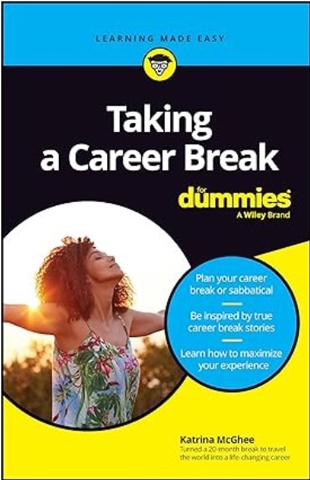This is one of those “For Dummies” books. We wouldn’t normally review a book in this series. They have volumes on writing computer code, physics, and learning Spanish. But they also publish volumes in the area of personal growth. We found this one special.
The author is promoted as someone who “turned a 20-month break to travel the world into a life-changing career.” That is not what we found most useful, because most readers don’t have the luxury of a two-month break from work to travel, let alone a 20-month break. But stick with us.
McGhee’s book encourages you to break out of your ordinary patterns, to be courageous, to remember your dreams and goals, and to use vision and creativity. It's not uncommon for the workplace to suck the vision and creativity out of us. This is why we laugh so easily at television shows and movies that show painfully dysfunctional, habit-forming workplaces — because they ring true. It doesn’t have to be that way. More than ever, people are finding ways to take chances on job changes and career changes.
People are also finding ways to take a break between job changes. McGhee writes encouragingly: “Have you been longing for a change? Maybe you wish life would slow down and give you some breathing room or simply that you could feel more joyful along the way.”
She addresses the self-doubts that people feel when they consider taking time off between jobs to rejuvenate themselves. Doubts include “You’re being irresponsible” and “You’ll ruin your career.” In the section of doubt called “You can’t afford a break,” she begins by saying, “A break is an investment — in you! It’s a chance to prioritize and invest in your well-being, your dreams, and your enjoyment of life.”
There are also encouragements regarding job changes and breaks as healthy choices, appealing, for instance, to the gratitude you will feel as a result: “Gratitude is potent. It can reduce stress and symptoms of anxiety and depression, promote better sleep, and boost your immune system.”
She then gives a variety of practical tools for making a career jump. These include recommended courses and podcasts, journaling, meditation, physical activities, and ways to build deeper connections with others.
The resources here include advice in Part 1 for “deciding whether a break is right for you,” followed by Part 2’s “planning your career break.” Later on, under “ten ground rules for a successful break,” the book encourages readers to be courageous and take a leap into what might feel scary:
“It may be difficult at first, but one of the best things you can do for yourself is to fully disconnect from your work life when you start the break. Your brain might want to panic about being out of the loop, losing touch with your network, and falling behind in your career. But that’s what the re-entry period is for. You can reconnect with everyone and everything after you’ve achieved the main goals of your break.”
Go Deeper:
Re-Storying Your Life: An E-Course that guides you through "life review" of your history, grief and gratitude, present path, and legacy.
